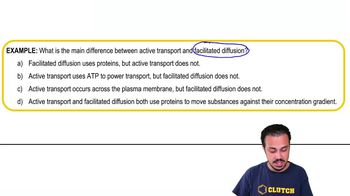Active Transport quiz Flashcards
 Back
BackTerms in this set (32)
What is the main difference between primary active transport and secondary active transport?
Primary active transport is directly driven by ATP hydrolysis, while secondary active transport is driven by another molecule's concentration gradient.
How does primary active transport move molecules across the membrane?
It moves molecules against their concentration gradient from areas of low concentration to areas of high concentration using energy from ATP.
What is a classic example of primary active transport?
The sodium-potassium pump is a classic example of primary active transport.
How many sodium and potassium ions are moved by the sodium-potassium pump, and in which directions?
The sodium-potassium pump exports 3 sodium ions out of the cell and imports 2 potassium ions into the cell.
What mnemonic can help you remember the number of sodium ions exported by the sodium-potassium pump?
The sodium symbol 'Na+' has 3 characters, which can help you remember that 3 sodium ions are exported.
What mnemonic can help you remember the number of potassium ions imported by the sodium-potassium pump?
The potassium symbol 'K+' has 2 characters, which can help you remember that 2 potassium ions are imported.
What role does ATP play in primary active transport?
ATP provides the energy required to pump molecules against their concentration gradients.
What is the function of the sodium-potassium pump in maintaining ion concentration gradients?
It maintains a low concentration of sodium ions inside the cell and a high concentration of potassium ions inside the cell.
What is the term for a transporter that moves molecules in opposite directions across the membrane?
An antiporter.
What drives secondary active transport if not ATP hydrolysis?
Secondary active transport is driven by the concentration gradient of another molecule.
How is the concentration gradient used in secondary active transport generated?
The concentration gradient is generated using primary active transport.
What is an example of secondary active transport?
The sodium-glucose transporter is an example of secondary active transport.
How does the sodium-glucose transporter work in secondary active transport?
Sodium ions move down their concentration gradient, releasing energy that powers the transport of glucose against its concentration gradient.
- What is the main difference between primary active transport and secondary active transport?Primary active transport is directly driven by ATP hydrolysis, while secondary active transport is driven by another molecule's concentration gradient.
- Why does active transport require energy?Active transport requires energy because it moves molecules against their concentration gradients from areas of low concentration to areas of high concentration.
- What molecule is commonly used as the energy source for primary active transport?ATP (Adenosine Triphosphate) is commonly used as the energy source for primary active transport.
- How does secondary active transport utilize the concentration gradient?Secondary active transport uses the concentration gradient established by primary active transport to drive the movement of other molecules.
- What is the role of ATP hydrolysis in active transport?ATP hydrolysis releases energy that is used to power primary active transport.
- What type of transport is the sodium-potassium pump an example of?The sodium-potassium pump is an example of primary active transport.
- How many sodium and potassium ions does the sodium-potassium pump move, and in which directions?The sodium-potassium pump moves 3 sodium ions out of the cell and 2 potassium ions into the cell.
- What term describes the sodium-potassium pump's movement of ions in opposite directions?The sodium-potassium pump is described as an antiporter because it moves ions in opposite directions.
- What is the driving force for simple diffusion?The driving force for simple diffusion is the concentration gradient.
- What is the difference between ATP and ADP in the context of energy release?ATP releases energy when hydrolyzed, while ADP does not release energy.
- How are primary and secondary active transport related?Secondary active transport uses the concentration gradient established by primary active transport.
- What process breaks apart ATP to release energy?The process of breaking apart ATP to release energy is called hydrolysis.
- What is the main function of active transport in cells?The main function of active transport is to move molecules against their concentration gradients, which requires energy.
- What is the role of the concentration gradient in secondary active transport?In secondary active transport, the concentration gradient established by primary active transport is used to drive the movement of other molecules.
- What is the significance of ATP in cellular functions?ATP is a crucial energy molecule used in many cellular functions, including active transport.
- which of the following is a type of active transport?Primary active transport and secondary active transport are types of active transport.
- how does the sodium-potassium pump make the interior of the cell negatively charged?The sodium-potassium pump exports 3 sodium ions out of the cell and imports 2 potassium ions into the cell, resulting in a net loss of positive charge inside the cell, making the interior negatively charged.
- giving energy to the __________ can move molecules against the concentration gradient.Giving energy to the sodium-potassium pump can move molecules against the concentration gradient.
- which of the following membrane activities requires energy from atp hydrolysis?Primary active transport, such as the sodium-potassium pump, requires energy from ATP hydrolysis.



